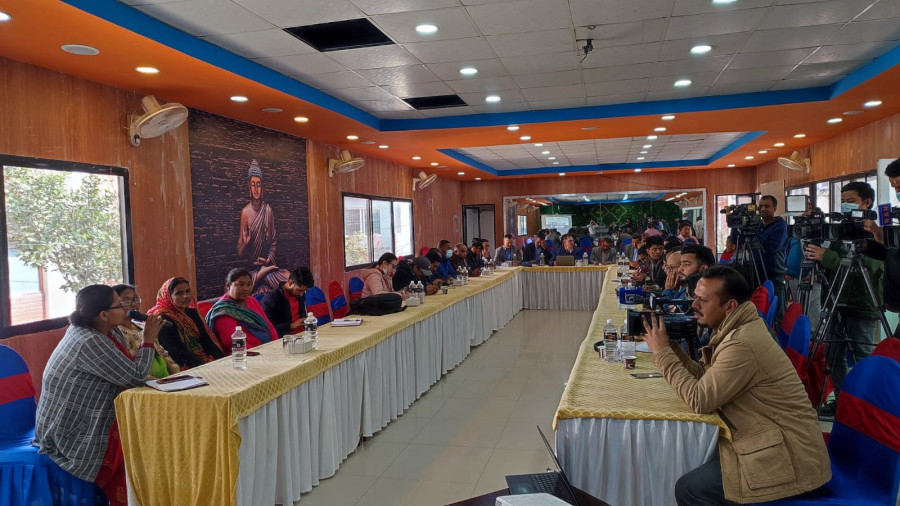Money
Small borrowers ruined by exorbitant interest rates
Insiders say the actual number of victims of microfinance companies may be in the hundreds of thousands.
Subin Adhikari
Former owner of a retail store Dil Kumari Karki now washes dishes after going bankrupt. Karki had opened a small grocery in Rautahat with Rs100,000 borrowed from neighbours. She expanded the shop by borrowing more money, and eventually her loans piled up to Rs450,000.
When her creditors began asking for their money back, she turned to microfinance companies for more loans.
The microfinance companies decided to squeeze her after finding out about her predicament, and demanded up to 36 percent interest. Karki made interest repayments to her neighbours by borrowing from various microfinance companies.
She owed money to 10 creditors, including five microfinance companies—Forward, Mero Microfinance, Mithila, Deprosc and Sana Kisan.
“I decided to sell a kattha of my land to repay my debts. I found a buyer who agreed to pay me Rs1 million per kattha, but later he backed out,” said Karki.
The interest on her loans has been piling up, and the microfinance companies have been coming to her house regularly.
Karki said her debts bloated to Rs4.5 million in the last four years due to high interest rates. “The microfinance companies also seized my land.”
She is under constant mental torture, and now washes dishes in people's homes in Kathmandu, earning up to Rs10,000 per month. She uses most of her income to send her son to school.
Shyam Kumari Chaudhary of Devipur in Siraha has a similar story of woe.
She borrowed Rs20,000 from a microfinance company when her father fell ill and had to be taken to India for treatment.
She paid back Rs11,000 after returning from India, and planned to pay the remaining Rs9,000 later.
Not long after, Chaudhary was stunned to find out that the interest on the Rs9,000 had ballooned to Rs120,000.
“I paid Rs120,000 to the microfinance company. They say I still have to pay Rs40,000 more.”
The microfinance company has been threatening me. “If I don't pay Rs40,000 within a few days, I will have to pay an additional Rs20,000 as penalty,” said Chaudhary, speaking at a programme in Kathmandu on Monday.
Chaudhary said company officials came to her home at night and threatened her family to pay the debt.
Karki and Chaudhary are a few examples of debtors being ruined by usurious interest rates.
About a dozen other victims related their experiences of being cheated by microfinance companies at an interaction organised by the Society of Economic Journalists-Nepal in Kathmandu on Monday.
Insiders say the actual number of victims of microfinance companies may be in the hundreds of thousands. A large number of them have not complained out of fear.
The concept of microfinance, now in wide practice in Nepal, dates back to the 1970s when a Bangladeshi economics professor Muhammad Yunus established Grameen Bank to provide microcredit to women to set up micro businesses.
This model contributed greatly to uplifting thousands of Bangladeshis out of poverty, and Yunus and Grameen Bank even received the Nobel Peace Prize in 2006 for their work.
His model of microfinance was replicated all over the world and in Nepal too.
Harihar Dev Pant, former deputy governor of Nepal Rastra Bank, is credited with introducing the Bangladeshi model of microfinance in Nepal some 30 years ago.
Microfinance companies are registered and regulated by Nepal Rastra Bank, the country’s central bank. There are 64 microfinance companies currently in operation.
Bharat Singh Thapa, assistant professor of microfinance at Tribhuvan University, said that microfinance companies work on the collaborative effort of financial and social capital.
“In the case of Nepal, these companies have turned themselves into shadow banks to collect deposits and provide loans,” said Thapa. “The social aspect has been destroyed.”
Thapa stated that the existing model of microfinance has failed.
“There is a need to remodel it in order to make it functional in a better way. Due to the absence of discipline in microfinance companies, low-income people are at risk of falling prey to profiteering individual lenders,” added Thapa.
Most of the victims stated that microfinance companies have now turned into loan sharks.
"The central bank has adopted a liberal policy to regulate microfinance companies as compared to other financial institutions due to its social factor," said Rewati Nepal, executive director of Nepal Rastra Bank.
According to him, microfinance companies are allowed to issue collateral-free loans of up to Rs1.5 million. They can charge only up to 15 percent interest and take 1.5 percent service charge.
“I request the victims, who have been asked to pay unlawful interest rates to immediately file a complaint with the central bank. We will take action without any delay," said Nepal.
Speaking at the programme, representatives of microfinance companies admitted that there were some problems in the sector.
“The board of directors set high targets for executive officers. As a result, they engage in dirty games to meet the deposit and loan targets," said Janardan Dev Pant, CEO of Nirdhan Utthan Laghubitta Bittiya Sanstha.
“Because of the ill intentions of a few, there is a risk of all the achievements and contributions of microfinance being overshadowed.”
The victims say that company employees also manhandle and abuse borrowers, and confiscate their belongings.
“Many people have committed suicide, several have been forced to flee their homes, and some have even been compelled to engage in prostitution to repay their debts to microfinance companies,” said Poonam Mahato, a victim from Lahan. “Who will take responsibility for that?”
The victims accuse officials of microfinance companies of putting poor people in a debt trap and then looting them for life.
“This problem has existed in the microfinance sector for a long time. The pandemic and liquidity crisis caused a sudden outburst,” said Mani Ram Gyawali, leader of an ad hoc committee formed to protest against microfinance companies.




 11.12°C Kathmandu
11.12°C Kathmandu













%20(1).jpg&w=300&height=200)
